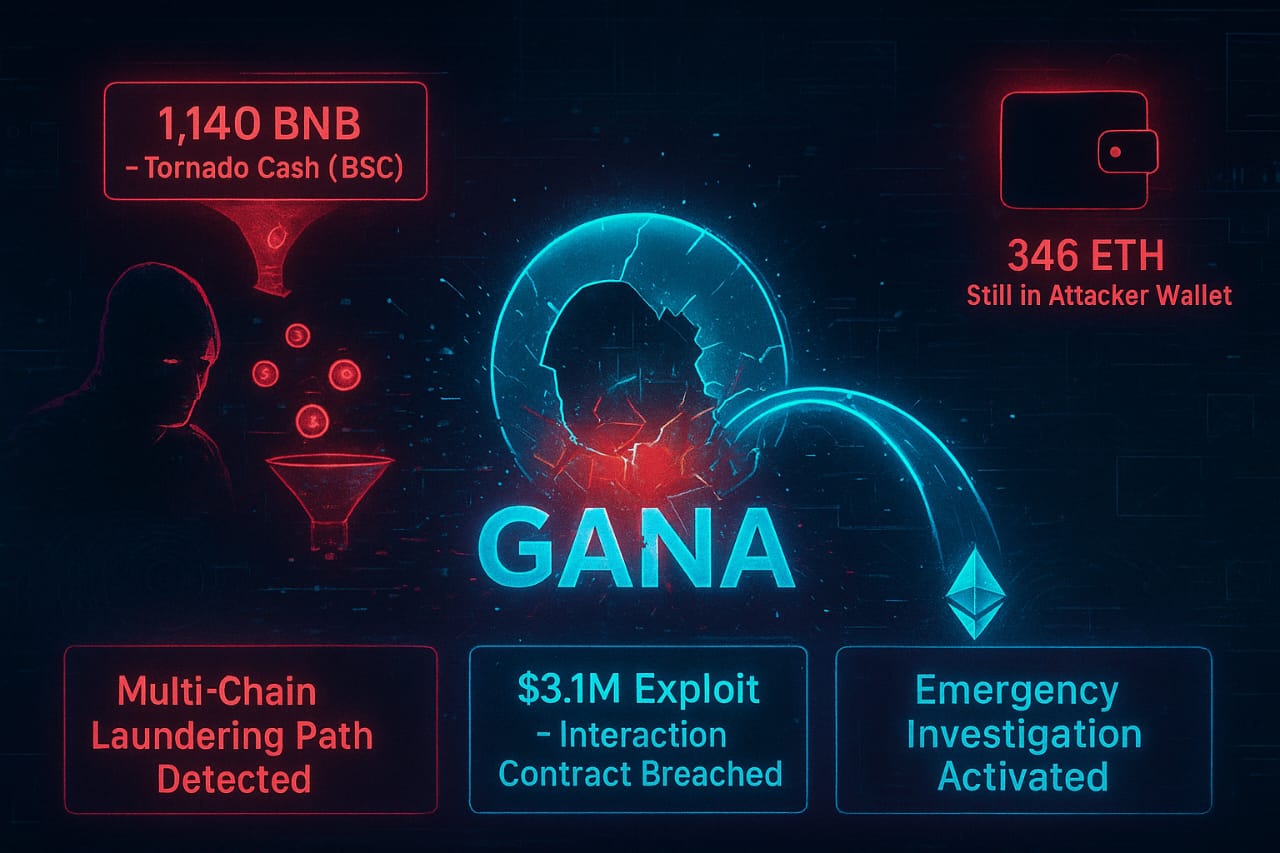
GANA Payment Hit by $3.1 Million DeFi Exploit: What Happened?
In a devastating development for the emerging decentralized finance (DeFi) sector, GANA Payment—a promising new player in the PayFi arena—has suffered a major security breach. The attack, which drained over $3.1 million from the platform, exposes the inherent risks of blending payment solutions with blockchain infrastructure. Here’s a detailed breakdown of the incident.
What Happened to GANA Payment?
The breach, first reported by blockchain investigator ZachXBT, was carried out with a degree of precision rarely seen in recent DeFi exploits. The attacker initiated the exploit by targeting GANA’s interaction contract on Binance Smart Chain (BSC). Within hours, the stolen funds were laundered using Tornado Cash and cross-chain bridges, ensuring their traceability was minimized.
Key movements included:
- 1,140 BNB ($1.04M) deposited into Tornado Cash on Binance Smart Chain.
- Bridge transfer of stolen funds from BSC to Ethereum.
- 346 $ETH ($1.05M) deposited into Tornado Cash on Ethereum.
Even after these transfers, a significant amount of funds still remain in a separate Ethereum wallet controlled by the attacker, signaling a multi-step plan to evade detection.
Why This Incident is a Setback for GANA Payment
The timing of this attack couldn’t have been worse for GANA Payment, which launched its PayFi solution with the aim of revolutionizing cross-border remittances and merchant payments. By integrating features like programmable transfers, real-time auditing, and reduced transaction fees, the platform intended to attract users in emerging markets underserved by traditional banking services.
Unfortunately, this exploit now raises serious concerns about the platform’s technical security and readiness to manage user funds at scale.
GANA’s Response to the Incident
Following the breach, GANA Payment released an official statement acknowledging the exploit and outlining the steps they are taking to address the situation.
- Asset Recovery: A full mapping of user asset addresses is underway to assess all affected balances and contract permissions.
- Contract Evaluation: The team is identifying vulnerabilities within the exploited contract.
- Reboot Plan: A comprehensive recovery timeline has been promised, including detailed steps for compensating affected users.
- Transparency: GANA is working with a third-party security firm to ensure a thorough investigation.
In their statement, GANA reassured users: “Protecting your assets is our highest priority.” Regular updates will be shared through their official platforms.
What This Means for the DeFi and PayFi Ecosystem
The GANA Payment exploit highlights a broader issue facing PayFi platforms that merge DeFi features with traditional payment infrastructures. Such projects face elevated security challenges due to the complexity of integrating programmable transfers, cross-border transaction flows, and financial auditing tools.
While the DeFi space continues to innovate with solutions that promise lower fees and faster transactions, this incident serves as a reminder of the need for advanced security protocols, independent code audits, and ongoing threat assessments.
For users seeking a high-quality digital wallet for secure transactions, consider trusted alternatives like the Ledger Nano X. It provides robust hardware-based security for managing cryptocurrencies, safeguarding assets from potential exploits and breaches.
Moving Forward: GANA Payment’s Next Steps
As GANA works to recover from this breach, it faces three critical priorities:
- Redesigning the exploited contract architecture to prevent future vulnerabilities.
- Implementing a clear, user-first recovery and compensation plan.
- Rebuilding trust by offering full transparency and independent verification of all recovery efforts.
If executed effectively, these measures could help GANA restore its reputation and demonstrate resilience, a critical trait for any emerging player in the competitive DeFi ecosystem.
The Broader Implications for PayFi Security
This attack underscores the evolving complexity of DeFi exploits. The attacker’s use of Tornado Cash and cross-chain bridges demonstrates the need for more robust tracking tools and compliance measures across blockchain networks. As the PayFi sector grows, platforms will need to strike a delicate balance between innovation and security to maintain user confidence.
For now, GANA’s response will serve as a litmus test for how new entrants can navigate crises in an industry increasingly targeted by sophisticated attacks.



